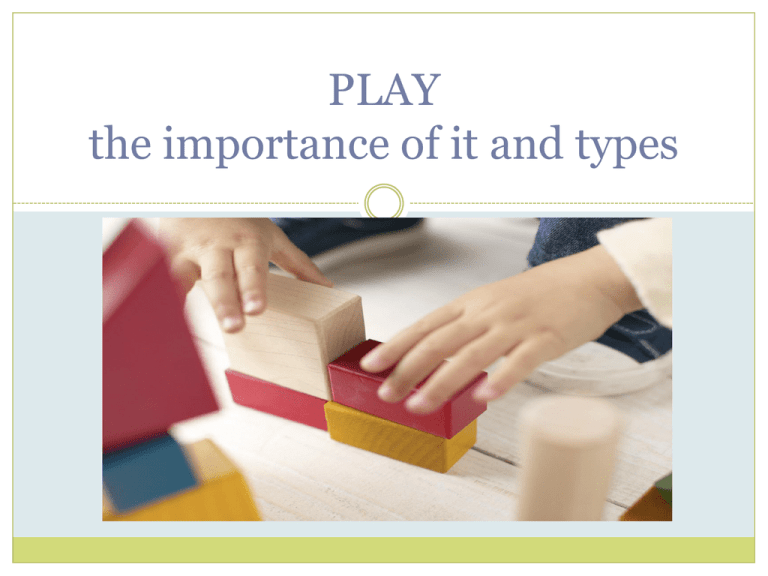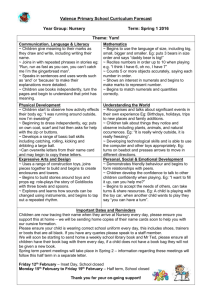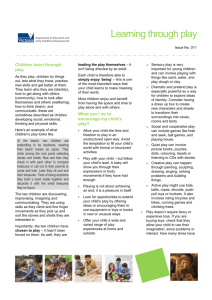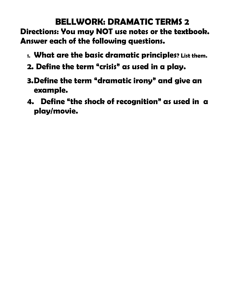Play - Davis School District
advertisement

PLAY the importance of it and types Play is a child’s WORK, the most important work they will ever do. Adult’s work is WORK Student’s work is SCHOOL Child’s work is PLAY and they do it all day long! Think of play as a study break from learning, but they continue learning. 1. Play is important because… It is how children learn, grow, and develop. enhances creativity they learn about themselves, others, and their world builds confidence releases energy builds initiative and autonomy (Erikson) PLAY develops the 5 basic areas of Growth and Development: Physical: Gross/fine motor skills, speed, strength, coordination Emotional Handle feelings, fears, how to express emotions, and other’s emotions Social Acceptable social behavior, understand cooperation Cognitive How things work, problem solving, reasoning, and practice mental skills Moral Honesty, rules, consideration, respect Decide which area of development each activity would enhance. More than one can apply. ______ Puzzles ______ Painting ______ Tricycle ______ Acting out Stories ______ Playground Equipment _____ Play kitchen ______ Matching picture cards ______ Candyland game ______Books ______Trucks / Cars ______Dolls ______Ball C = cognitive S = social P = physical E = emotional M = moral 2. Areas of Play (social classifications) Solitary Play Onlooker Play Parallel Play Associative Play Preschool Cooperative Play Preschool Unoccupied Behavior 1. UNOCCUPIED BEHAVIOR: The child is not involved in any particular activity. He/she just observes what seems interesting at the time. When nothing of interest is happening, he/she will walk around, look around, or play with his/her fingers, hair, etc. The child often appears to be day dreaming. 2. ONLOOKER BEHAVIOR: This behavior involves watching other children play. The child may talk to the children whoa re playing but does not become actively involved. The onlooker wants to be close enough to interact with the children who are playing whereas the unoccupied child’s interest keeps shifting to anything that interests him/her at the moment. (TODDLERS) 3. SOLITARY PLAY: This type of play involves a child playing alone. He/she has no interest in anyone else or that they are doing. The toys he/she plays with are different from those the other children are playing with. He/she is totally involved in a personal activity. (INFANTS) 4. PARALLEL PLAY: This type of play involves a child playing beside other children. There is no actual interaction, but the toys are similar. The child is playing beside the other children rather than with them. (2-3 YEARS) 5. ASSOCIATIVE PLAY: This type of play involves a child playing with other children. The children share toys and interact with one another. Children are involved in similar but not identical activity. There is no specific organization of activities. Each child does what he/she wishes but is a part of a large group. (3 YEAR – SCHOOL AGE) 6. COOPERATIVE PLAY: This type of play involves organization. The child is a part of a group that has a specific purpose in mind such as making an art project or playing a game. There are usually leaders and followers in this type of play. 3. Types of Play Active / Rough and Tumble -This looks like fighting, but it is a great release of energy and builds physical and social skills. -sports, play sword fight, wrestle, chase, playground Sensory Motor -Using senses and motor skills to learn. If they use all 5 senses at the same time, they will learn best. -Play dough, sand, finger paint, listening activities Dramatic / Make-believe/ Pretend -Situations that teach real life and allow a child to express themselves and their emotions -Playing dress-up, house, doctor, store, etc… Manipulative -Using objects to learn with – best way to learn. -Math block, blocks, chain links, dice, foam shapes Skill Mastery / Creative -Learning a new skill so repeating it over and over. They see the progress as they master this new skill and it build self-confidence and self-esteem. -Cutting, video games, jump rope, soccer Passive -Having no interaction with others. All children need this, but keep it limited. -Watching TV, reading, computer, video games, Daydreaming, musical instrument, coloring…. 4. How Parents Destroy the value of play Purpose and Timing Parents are eager to provide a toy for the child. To young for it, not interested at time, not their type Too many toys Child has too many toys to play with. Confusion, overwhelming, too many choices Self-conscious Play Parents enter child’s play too actively or at the wrong time. They might laugh, ask a question, make suggestions, or criticize the child’s play. Toys for boys and Toys for girls Child has been stereotyped and only has gender appropriate toys, games, and activities. Let them choose their own interests. Competition Parents make play a competition – be the best, do it first, make it right. Child is better at something than their friends and friends don’t enjoy playing with them Hinder Creativity Parent’s not allowing kids to be kids and explore, experiment, play, get dirty, make mistakes, and following protocol of how it is to be in the real adult world. This is a child’s world 5. How Parents Can Foster Play (strengthen and help develop it) Relax the Controls Be the Child’s Advocate Inspire Perseverance Provide a Creative Tolerate Differences Environment Let them be kids Allow for Free Play Puzzles, computers. Dramatic play, play-dough, basketball hoop, climbing stuff, toys… “What would you like to do today?” “I don’t know” Aimless wandering Give ideas and show activities Child gives no response Notice where their eyes are looking and facial expressions of interest Give ideas and show activities Find them a friend Doing the same activity everyday Encourage variety and point what others are doing. How did you get there? Have children stand in a line with one leader (adult) and the other adult leader stands across the yard or room. The leader without children yells : “___, _____, how did you get there?” (filling in the blanks with an animal or a mode of transportation) The other adult leader yells the mode of movement for that animal or vehicle. ex. "Snake, snake, how did you get there?" "We slithered!" At this point all the children pretend to be that thing and slither to the other leader. It goes back and forth as long as the attention of your children. Use horses, elephant, frog, bees, motorcycles, helicopter, racecars, airplanes, etc. … DRAMATIC PLAY IMITATE REAL-LIFE SITUATIONS THINK OF IT AS A STAGE WHERE THE CHILD ENTERS AND IMMEDIATELY TAKES ON A ROLE AND PRETENDS. - PARENTING, COOKING, DOCTOR, TEACHER, GROCERY STORE, OFFICE, HAIR SALON, ETC. - Best done when restrictions are few and possibilities are endless. Be aware of Culture!! Supply pictures and props that represent different races, and types of culture. Benefits of Dramatic Play Provides an outlet of the child’s inner thoughts and feelings. Develops problem solving skills, cause and effect, decision making, autonomy, and self-image. Practice language development as they develop plots Develops and creates opportunities for social interactions Teaches about occupations and roles and how to do them in real life. Dramatic play allows children to learn about and experience their world. Caregiver’s Role in Dramatic Play COACHING: Provide children with problem solving ideas. Child may not want to be a baker because there is not a baker’s hat. You help them make a paper hat A child is hitting and you tell them to stop because the child does not like it and then direct them through solving the issue. MODELING: Show them appropriate ways to play a part. In a shoe store the child may not know how to sell shoes so you say," Would you like to buy some shoes today?” Your child looks hungry, shouldn’t you go and feed him? CREATING the SPACE Separate area that can have 3 sides. Walls, dividers, shelves, and furniture can be used. Near other noisy areas. Ample space to build and develop – flat and carpeted Near block area so they can share supplies Containing real life items. It is often based on the day’s theme. Theme: Weather Prop Box Supplies BEAUTY SALON Brushes- cordless blower- empty product bottles- mirrors- apronsemery boards- magazines- play cosmetics- play money DRESS-UP CLOTHES Shoes -scarves -jewelry -hats - wigs suitcases - bags - keys FURNITURE Stove - refrigerator - child-sized table & chairs - - mirrors dolls - doll bed & high chair KITCHEN EQUIPMENT Pots & Pans, Utensils - cooking equipment Clock - telephone food Look at basic junk items as creative opportunities! Use toilet paper rolls to create a real life object like binoculars. Take small empty clear water bottles, fill them half full with water and food coloring, then hot glue the cap on. The kids love pretending to drink these different "juices". Shred colored paper into empty spice containers . How about a cardboard box? Act out a Story or a Book Read a book like Brown bear, Brown Bear. Create face puppets using paper plates. Then act out the book using the paper plate masks. PUPPETS Made out of anything! A self conscious child can hide behind a puppet and act out feelings or be anything. they may say things to or through a puppet that they would not say to anyone else. The teacher can use puppets to motivate and teach the children Often they will listen to a puppet over a teacher. Dramatic Play Prop Box • LOOK AT YOUR PRESCHOOL LESSON THEMES • LIST 10 ITEMS THAT YOU CAN REALISTICALLY PUT IN YOUR DRAMATIC PLAY AREA. IMAGINATION! USE YOUR What would you put in a Royalty box or a Gardner box? EXAMPLE: TEACHER Book, Paper, Chalk, Crayons, Ruler, Glasses, Black Construction Paper, Calculator, Markers, Notebook. Other ideas: A Camping Trip Close your eyes and draw the camping scene that I will tell you: A lake A boat on the lake A man in the boat fishing A fish on the end of the hook A tent on the shore of the lake A camp fire with flames A dog by the campsite Mountains in the background The sun peaking through the mountains Clouds in the sky A wolf howling on top of the mountain Open your eyes and look at your picture Small (Fine) Play • Builds Language skills • Builds Social skills • Builds Cognitive skills – thinking, reasoning, problem-solving, understanding • These skills develop the ability to write, color, draw, manipulate small objects and toys, accomplish self-help tasks. To Carefully Select Materials for Play Select open-ended toys that have a variety of uses like: Small Motor Play Sand or water or other sensory table play Painting Puzzles Playdough Cutting Threading (beads and lacing cards) All art is fine motor, but not all fine motor is art. Sorting objects (beans) Boardgames BLOCK AREA Blocks, lego’s, lincoln logs, .. Away from quiet areas and next to noisy areas like dramatic play. Use the shelves for walls and storage Ample space to build without getting in the way of others. Flat carpeted surface for warmth, comfort, and noise control Provide Props other than blocks: furniture, people, cars, animals, road signs….. Establish simple rules to keep the “construction site’ safe. We use blocks for building We take blocks as we need them We clean up our blocks when we are finished • I Wiggle I wiggle my fingers. I wiggle my toes. I wiggle my shoulders. I wiggle my nose. Now no more wiggles are left in me. I sit as quiet, as quiet as can be. LARGE (GROSS) PLAY Enhance learning Included daily Teaches habits of activity that will continue as they get older. Social growth OUTDOOR PLAY Develops motor skills At least 60 minutes of physical activity a day – both inside and outside. Movement activities Jumping activities Climbing activities Obstacle course activities Roll and Tumble activities Parachute activities Games Ball activities Planning Outdoor Environments • Enough empty space but not Dead space – Lots of grass and trees to run around • Broad, easily visible paths • Children in one unit cannot reach children in another unit • The children should not have to walk through one area to get to another. The caregiver should be able to see all areas of the playground easily. Provide a multipurpose equipment for child stimulation. Utah State Law requires: • 40 square feet per child or an acceptable alternative. • It must be fenced with a five foot fence. • A shaded area must be provided. Dinovember • http://www.dailymail.co.uk/news/article2507305/Dinovembers-toy-dinosaurscome-life-creative-parents-spark-webcraze.html PROPS • The performers are split into pairs, each given a different unusual prop. The pairs alternate at the prompting of the host's buzzer, giving short scenes using their prop in a unique way.





